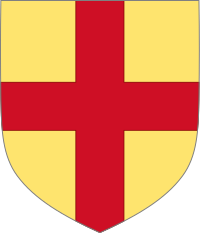William Donn de Burgh, 3rd Earl of Ulster
William Donn de Burgh, 3rd Earl of Ulster | |
|---|---|
Uilleag Donn de Búrca | |
 Arms of William Donn de Burgh: Or, a cross gules.[1] | |
| Lieutenant of Ireland | |
| In office 3 March 1331 – 5 November 1331 | |
| Preceded by | John Darcy |
| Succeeded by | Anthony de Lucy |
| Personal details | |
| Born | 13 September 1312 |
| Died | 6 June 1333 (aged 20) |
| Spouse | Maud of Lancaster |
| Children | Elizabeth de Burgh, 4th Countess of Ulster |
| Parent(s) | John de Burgh Elizabeth de Clare |
William de Burgh, 3rd Earl of Ulster and 4th Baron of Connaught (English: /dˈbɜːr/; d’-BER; 17 September 1312 – 6 June 1333) was an Irish noble who was Lieutenant of Ireland (1331) and whose murder, aged 20, led to the Burke Civil War.
Background[edit]
The grandson of the 2nd Earl Richard Óg de Burgh via his second son, John, William de Burgh was also Lord of Connaught in Ireland, and held the manor of Clare, Suffolk.
He was summoned to Parliament from 10 December 1327 to 15 June 1328 by writs addressed to Willelmo de Burgh. He is considered the first Baron Burgh. In March 1331 he was appointed Lieutenant of Ireland, serving until November 1331.[2]
Marriage and issue[edit]
The 3rd Earl of Ulster married, before 16 November 1327 (by a Papal Dispensation dated 1 May 1327), Maud of Lancaster, daughter of Henry, 3rd Earl of Lancaster and Maud Chaworth. They had one surviving child, Elizabeth, who was 13 months old when her father was murdered.
She married Lionel of Antwerp, third son of Edward III of England.
Maud remarried Sir Ralph Ufford, Justiciar of Ireland 1344–46, and had further issue. She was said to have had great influence over her second husband.
Murder[edit]

In February 1332, at Greencastle, near the mouth of Lough Foyle, he had his cousin Sir Walter Liath de Burgh starved to death. In revenge, Sir Walter's sister, Gylle de Burgh, wife of Sir Richard de Mandeville, planned his assassination.
In June 1333, he was killed by de Mandeville, Sir John de Logan, and others. His widow, Maud (or Matilda), offered a reward for the capture of de Mandeville and his wife.[3]
The Annals of the Four Masters noted that
"William Burke, Earl of Ulster, was killed by the English of Ulster. The Englishmen who committed this deed were put to death, in divers ways, by the people of the King of England; some were hanged, others killed, and others torn asunder, in revenge of his death."
Maud fled to England, where she remarried, was again widowed in 1346, and then became an Augustinian canoness at Campsey Priory in Suffolk, where she is buried. Upon his death, the various factions of the de Burghs, now called Burke, began the Burke Civil War for supremacy.[4]
Ancestry[edit]
| Ancestors of William Donn de Burgh, 3rd Earl of Ulster | ||||||||||||||||||||||||||||||||||||||||||||||||||||||||||||||||||||||||||||||||||||||||||||||||||||||||||||||||||||||||||||||||||||||||||||||||||||||||||||||||||||||||||||||||||||||||||||||||||||||||||||||||||||||||||||||||||||||||||||||||||||||||||||||||||||||||||||||||||||||||||||||||||||||||||||||||||||||||||||||||||||||||||||||||||||||||||||||||||||||||||||||||||||||||||||||||||||||||||||||||||||||||||||||||||||||||||||||||||||||||||||||||||||||||||||||||||||||||||||||||||||||||||||||||||||||||||||||||||||||||||||||||||||||||||||||||||||||||||||||||||||||||||||||||||||||||||||||||
|---|---|---|---|---|---|---|---|---|---|---|---|---|---|---|---|---|---|---|---|---|---|---|---|---|---|---|---|---|---|---|---|---|---|---|---|---|---|---|---|---|---|---|---|---|---|---|---|---|---|---|---|---|---|---|---|---|---|---|---|---|---|---|---|---|---|---|---|---|---|---|---|---|---|---|---|---|---|---|---|---|---|---|---|---|---|---|---|---|---|---|---|---|---|---|---|---|---|---|---|---|---|---|---|---|---|---|---|---|---|---|---|---|---|---|---|---|---|---|---|---|---|---|---|---|---|---|---|---|---|---|---|---|---|---|---|---|---|---|---|---|---|---|---|---|---|---|---|---|---|---|---|---|---|---|---|---|---|---|---|---|---|---|---|---|---|---|---|---|---|---|---|---|---|---|---|---|---|---|---|---|---|---|---|---|---|---|---|---|---|---|---|---|---|---|---|---|---|---|---|---|---|---|---|---|---|---|---|---|---|---|---|---|---|---|---|---|---|---|---|---|---|---|---|---|---|---|---|---|---|---|---|---|---|---|---|---|---|---|---|---|---|---|---|---|---|---|---|---|---|---|---|---|---|---|---|---|---|---|---|---|---|---|---|---|---|---|---|---|---|---|---|---|---|---|---|---|---|---|---|---|---|---|---|---|---|---|---|---|---|---|---|---|---|---|---|---|---|---|---|---|---|---|---|---|---|---|---|---|---|---|---|---|---|---|---|---|---|---|---|---|---|---|---|---|---|---|---|---|---|---|---|---|---|---|---|---|---|---|---|---|---|---|---|---|---|---|---|---|---|---|---|---|---|---|---|---|---|---|---|---|---|---|---|---|---|---|---|---|---|---|---|---|---|---|---|---|---|---|---|---|---|---|---|---|---|---|---|---|---|---|---|---|---|---|---|---|---|---|---|---|---|---|---|---|---|---|---|---|---|---|---|---|---|---|---|---|---|---|---|---|---|---|---|---|---|---|---|---|---|---|---|---|---|---|---|---|---|---|---|---|---|---|---|---|---|---|---|---|---|---|---|---|---|---|---|---|---|---|---|---|---|---|---|---|---|---|---|---|---|---|---|---|---|---|---|---|---|---|---|---|---|---|---|---|---|---|---|---|---|---|---|---|---|---|---|---|---|---|---|---|---|---|---|---|---|---|---|---|---|---|---|---|---|---|---|---|---|---|---|---|---|---|---|---|---|---|---|---|---|---|---|---|---|---|---|---|---|---|---|---|---|---|---|---|---|---|---|---|---|---|---|---|---|---|---|---|---|---|---|---|---|---|---|---|---|---|---|---|---|---|---|---|---|---|---|---|---|---|---|---|---|---|---|---|---|---|---|---|---|---|---|---|
| ||||||||||||||||||||||||||||||||||||||||||||||||||||||||||||||||||||||||||||||||||||||||||||||||||||||||||||||||||||||||||||||||||||||||||||||||||||||||||||||||||||||||||||||||||||||||||||||||||||||||||||||||||||||||||||||||||||||||||||||||||||||||||||||||||||||||||||||||||||||||||||||||||||||||||||||||||||||||||||||||||||||||||||||||||||||||||||||||||||||||||||||||||||||||||||||||||||||||||||||||||||||||||||||||||||||||||||||||||||||||||||||||||||||||||||||||||||||||||||||||||||||||||||||||||||||||||||||||||||||||||||||||||||||||||||||||||||||||||||||||||||||||||||||||||||||||||||||||
References[edit]
Citations[edit]
- ^ Burke, Bernard (1884). The General Armory of England, Scotland, Ireland, and Wales; comprising a registry of armorial bearings from the earliest to the present time. University of California Libraries. London: Harrison & sons.
- ^ O'Mahony, Charles (1912). The Viceroys of Ireland. London: John Long Limited. p. 16.
- ^ "Close Rolls, Edward III: August 1337 Pages 151-172". British History Online. Retrieved 10 August 2022.
- ^ Frame, Robin (2004). "Burgh, William de, third earl of Ulster [called the Brown Earl] (1312–1333), magnate". Oxford Dictionary of National Biography (online ed.). Oxford University Press. doi:10.1093/ref:odnb/4001. ISBN 978-0-19-861412-8. Retrieved 21 December 2021. (Subscription or UK public library membership required.)
Bibliography[edit]
- Archer, Thomas Andrew (1886). . In Stephen, Leslie (ed.). Dictionary of National Biography. Vol. 7. London: Smith, Elder & Co.
- Burke, Bernard (1884). The General Armory of England, Scotland, Ireland, and Wales; comprising a registry of armorial bearings from the earliest to the present time. London: Harrison & sons.
- O'Mahony, Charles (1912). The Viceroys of Ireland. London: John Long Limited.
- Harbison, Sheelagh (1995), "Rindown Castle: a royal fortress in Co. Roscommon", Journal of the Galway Archaeological and Historical Society, 47
- Hayden, Alan (1988), "Excavation on the line of the medieval town defences of Loughrea, Co. Galway", Journal of the Galway Archaeological and Historical Society, 41 JSTOR 25535575
- Holland, Patrick (1993), "Anglo-Norman Galway; rectangular earthworks and moated sites", Journal of the Galway Archaeological and Historical Society, 46
- Holland, Patrick (1988), "The Anglo-Normans in Co. Galway: the process of colonization", Journal of the Galway Archaeological and Historical Society, 41 JSTOR 25535573
- Holland, Patrick (1997), "The Anglo-Norman landscape in County Galway; land-holdings, castles and settlements", Journal of the Galway Archaeological and Historical Society, 49
- Knox, Hubert T. (1908). The History of the County of Mayo to the close of the sixteenth century. Dublin: Hodges, Figgis and Company.
- MacLysaght, Edward (1978), The Surnames of Ireland, Dublin
{{citation}}: CS1 maint: location missing publisher (link) - Moody, T. W.; Martin, F. X.; Byrne, F. J., eds. (1989). A New History of Ireland: IX: Maps, Genealogies, Lists, A Companion to Irish History, Part II. Oxford: Oxford University Press. ISBN 978-0-19-959306-4.
- Earls of Ulster and Lords of Connacht, 1205–1460 (De Burgh, De Lacy and Mortimer), p. 170.
- O'Donovan, John (1843), The Tribes and Customs of Hy-Many, commonly called O'Kelly's Country, Dublin: Irish Archaeological Society
- Weiss, Frederick, Ancestral Roots of Certain American Colonists Who Came to America Before 1700, pp. Lines 73-30, 177B-8, 177B-9
External links[edit]
- Annals of Ulster at CELT: Corpus of Electronic Texts at University College Cork
- Annals of Tigernach at CELT: Corpus of Electronic Texts at University College Cork
- Revised edition of McCarthy's synchronisms at Trinity College Dublin.
